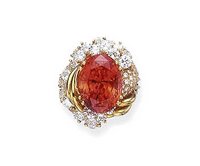

Quality, Rarity and Value, Pricing the Crème de la crème of Gems Part I.
By Richard W. Wise, G.G.
At Christies April 2006 Magnificent Jewels auction a pear shaped D IF diamond weighing 50.53 carats sold for 4.2 million (83,450 per carat), another D-color pear shape stone weighing 50.67 carats sold at the same auction for 2.6 million. The difference: two clarity grades, the second diamond was a GIA certed VVS2. The vast difference in the two prices brings into sharp focus the role of rarity in the pricing of a fine gemstone. I choose this example because the GIA grading system is precise and universally accepted. If there can be such a dramatic difference in value between two visually identical colorless diamonds consider the difficulty in pricing colored gemstones which are not so similar and for which no universally recognized system of grading exists. Lets take the worse case, consider the padparadscha sapphire.
A moment to define our terms; we are talking about a natural untreated g em.
On
June 7, 1995 Christies sold a magnificent 20.84 ct. padparadscha sapphire at $374,400 ($18,000 per carat).
What the heck is a padparadscha sapphire anyway?
Unlike ruby and blue sapphire, padparadscha cannot be separated from other varieties of corundum by chemical analysis or any other scientific test. Padparadscha is not a type or variety of sapphire, it is simply a color. So, what color is it? Most experts, at least those in the U. S. subscribe to Robert Crowningshield’s definition stated in an article published in Gems & Gemology Magazine in 1982:
“…this color range should be limited to light to medium tones of pinkish orange to orange-pink hues…”
This seems clear enough but consider the following:
“Lacking delicacy. (emphasis mine)The dark brownish-orange or even medium brownish-orange tones of corundum from East-Africa would not qualify under this definition. Deep orangy red sapphires likewise would not qualify as fitting this definition.”
How do you define delicacy in a gem lab? Ok, so delicacy in this context refers to “light to medium tone” as opposed to a dark robust tone, certainly definable even quantifiable.
but here comes the really difficult part. The definition of hue, pinkish-orange to orangy-pink, presents an almost infinite range of hues. Given the grading tolerances, one D color is pretty much like another, whereas two padparadscha sapphires can be worlds apart. How is it possible to develop comparables on gems with such a broad range of possible hues? And, what constitutes the most desirable and therefore most valuable hue? Is it a pink stone with an orange secondary or an orange stone with pink?
Working Without a Net:
Whether its a connoisseur, a serious collector or just a fussy consumer who desires the finest of the fine, will find himself working without a net. As you climb higher rarity assumes a greater role and as you approach the pinnacle smaller nuances in the four Cs of Connoisseurship; (color, cut clarity and crystal) that I define in detail in my book Secrets Of The Gem Trade, The Connoisseurs Guide To Precious Gemstones, make for broader variations in price.






3 comments:
there is a restored cartier necklace
I read this entire blog and got to the end before I realized who you are...I found your "Secrets of the Gem Trade" great. It's not written like a text book and you can actually read it. Of course I am a Gem Geek which could explain my fascination with the subject.
Thank You for your contribution to my education.
Richard: I found the 3 Part series an excellent read. I like the detail and elaboration you put forth concerning some issues which can be compared to a elaborate continuim to your book. Please keep posting.
-Josh, Rioux-Haines Alaska
Post a Comment